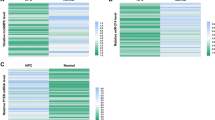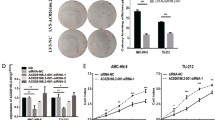Abstract
Nasopharyngeal carcinoma (NPC) is a kind of head-neck malignant tumor. lncRNA-PVT1 can promote the proliferation of carcinoma cells, and induce cells to have stem cell-like potentials. However, the function of PVT1 in NPC cells is not clear. The expressions of lncRNA-PVT1 and the expressions of the stem cell markers in NPC tissues or cell lines were investigated by qRT-PCR or western blot. The cell proliferation, and the ability of NPC cells to form spherical, clonal colonies were investigated by MTT assay, colony formation assay, and tumor-sphere formation assay. Cancer stem cells surface markers were detected by flow cytometry and western blot. PI3K/AKT signal activation in NPC cells was determined by western blot. PVT1 was significantly up-regulated in both NPC tissues and cell lines and associated with poor prognosis. PVT1 knockdown reduced NPC cells viability, clonogenicity, the cell surface CD44+/CD24− stem phenotype, and the expressions of the stem cell markers in NPC cells, including Oct4, c-Myc, SOX2, and ALDH. Furthermore, PVT1 negatively regulates the expression levels of miR-1207 in NPC cells and spheres cells, which is critical for NPC stemness. Knockdown of miR-1207 promoted stem phenotype and the expressions of the stem cell markers in NPC cells. Moreover, phosphor-PI3K (p-PI3K) and phosphor-AKT (p-AKT) were found to be down-regulated after PVT1 siRNAs transfection in NPC cells. And miR-1207 inhibitor transfection reversed the all the effects brought by PVT1 knockdown. Pvt1 promotes cancer stem cell–like properties in NPC cells via inhibiting miR-1207 and activating the PI3K/AKT signal pathway.






Similar content being viewed by others
References
Chou J et al (2008) Nasopharyngeal carcinoma--review of the molecular mechanisms of tumorigenesis. Head Neck 30(7):946–963
Xu T et al (2013) Recurrent nasopharyngeal carcinoma: a clinical dilemma and challenge. Curr Oncol 20(5):e406–e419
Albini A et al (2015) Cancer stem cells and the tumor microenvironment: interplay in tumor heterogeneity. Connect Tissue Res 56(5):414–425
Baccelli I, Trumpp A (2012) The evolving concept of cancer and metastasis stem cells. J Cell Biol 198(3):281–293
Visvader JE, Lindeman GJ (2008) Cancer stem cells in solid tumours: accumulating evidence and unresolved questions. Nat Rev Cancer 8(10):755–768
Han Y et al (2015) Advanced applications of RNA sequencing and challenges. Bioinform Biol Insights 9(Suppl 1):29–46
Cech TR, Steitz JA (2014) The noncoding RNA revolution-trashing old rules to forge new ones. Cell 157(1):77–94
Huang T et al (2013) Noncoding RNAs in cancer and cancer stem cells. Chin J Cancer 32(11):582–593
Huarte M (2015) The emerging role of lncRNAs in cancer. Nat Med 21(11):1253–1261
Schmitt AM, Chang HY (2016) Long noncoding RNAs in Cancer pathways. Cancer Cell 29(4):452–463
Wang Y et al (2015) A novel long non-coding RNA, hypoxia-inducible factor-2alpha promoter upstream transcript, functions as an inhibitor of osteosarcoma stem cells in vitro. Mol Med Rep 11(4):2534–2540
Zhou M et al (2016) LncRNA-Hh strengthen Cancer stem cells generation in twist-positive breast Cancer via activation of hedgehog signaling pathway. Stem Cells 34(1):55–66
Colombo T et al (2015) PVT1: a rising star among oncogenic long noncoding RNAs. Biomed Res Int 2015:304208
Graham M, Adams JM (1986) Chromosome 8 breakpoint far 3′ of the c-myc oncogene in a Burkitt's lymphoma 2;8 variant translocation is equivalent to the murine pvt-1 locus. EMBO J 5(11):2845–2851
Iaccarino I (2017) lncRNAs and MYC: An Intricate Relationship. Int J Mol Sci 18(7):1497
Tseng YY et al (2014) PVT1 dependence in cancer with MYC copy-number increase. Nature 512(7512):82–86
Huppi K et al (2008) The identification of microRNAs in a genomically unstable region of human chromosome 8q24. Mol Cancer Res 6(2):212–221
Cui M et al (2016) Long non-coding RNA PVT1 and cancer. Biochem Biophys Res Commun 471(1):10–14
Conte F et al (2017) Role of the long non-coding RNA PVT1 in the dysregulation of the ceRNA-ceRNA network in human breast cancer. PLoS One 12(2):e0171661
Cui D et al (2016) Long non-coding RNA PVT1 as a novel biomarker for diagnosis and prognosis of non-small cell lung cancer. Tumour Biol 37(3):4127–4134
Ding J et al (2014) Expression and clinical significance of the long non-coding RNA PVT1 in human gastric cancer. Onco Targets Ther 7:1625–1630
Gao YL et al (2017) Long non-coding RNA PVT1 facilitates cervical Cancer progression via negative regulating of miR-424. Oncol Res 25:1391–1398
Guo K et al (2017) The expression pattern of long non-coding RNA PVT1 in tumor tissues and in extracellular vesicles of colorectal cancer correlates with cancer progression. Tumour Biol 39(4):1010428317699122
Liu E et al (2015) Overexpression of long non-coding RNA PVT1 in ovarian cancer cells promotes cisplatin resistance by regulating apoptotic pathways. Int J Clin Exp Med 8(11):20565–20572
Zhang XW et al (2015) Overexpression of long non-coding RNA PVT1 in gastric cancer cells promotes the development of multidrug resistance. Biochem Biophys Res Commun 462(3):227–232
Zhuang C et al (2015) Tetracycline-inducible shRNA targeting long non-coding RNA PVT1 inhibits cell growth and induces apoptosis in bladder cancer cells. Oncotarget 6(38):41194–41203
Wang F et al (2014) Oncofetal long noncoding RNA PVT1 promotes proliferation and stem cell-like property of hepatocellular carcinoma cells by stabilizing NOP2. Hepatology 60(4):1278–1290
Alvarez ML et al (2013) Role of microRNA 1207-5P and its host gene, the long non-coding RNA Pvt1, as mediators of extracellular matrix accumulation in the kidney: implications for diabetic nephropathy. PLoS One 8(10):e77468
Marur S, Forastiere AA (2016) Head and neck squamous cell carcinoma: update on epidemiology, diagnosis, and treatment. Mayo Clin Proc 91(3):386–396
Hu S, Shan G (2016) LncRNAs in Stem Cells. Stem Cells Int 2016:2681925
Rosa A, Ballarino M (2016) Long noncoding RNA regulation of pluripotency. Stem Cells Int 2016:1797692
Wang Y et al (2013) Endogenous miRNA sponge lincRNA-RoR regulates Oct4, Nanog, and Sox2 in human embryonic stem cell self-renewal. Dev Cell 25(1):69–80
Yang YR et al (2014) Increased expression of the lncRNA PVT1 promotes tumorigenesis in non-small cell lung cancer. Int J Clin Exp Pathol 7(10):6929–6935
Franca GS, Vibranovski MD, Galante PA (2016) Host gene constraints and genomic context impact the expression and evolution of human microRNAs. Nat Commun 7:11438
Barsotti AM et al (2012) p53-dependent induction of PVT1 and miR-1204. J Biol Chem 287(4):2509–2519
Riquelme E et al (2014) Frequent coamplification and cooperation between C-MYC and PVT1 oncogenes promote malignant pleural mesothelioma. J Thorac Oncol 9(7):998–1007
Chen L et al (2014) miR-1207-5p and miR-1266 suppress gastric cancer growth and invasion by targeting telomerase reverse transcriptase. Cell Death Dis 5:e1034
Zhang S, Cui W (2014) Sox2, a key factor in the regulation of pluripotency and neural differentiation. World J Stem Cells 6(3):305–311
Rizzino A (2013) Concise review: the Sox2-Oct4 connection: critical players in a much larger interdependent network integrated at multiple levels. Stem Cells 31(6):1033–1039
Hadjimichael C et al (2015) Common stemness regulators of embryonic and cancer stem cells. World J Stem Cells 7(9):1150–1184
Leis O et al (2012) Sox2 expression in breast tumours and activation in breast cancer stem cells. Oncogene 31(11):1354–1365
Ginestier C et al (2007) ALDH1 is a marker of normal and malignant human mammary stem cells and a predictor of poor clinical outcome. Cell Stem Cell 1(5):555–567
Xia P, Xu XY (2015) PI3K/Akt/mTOR signaling pathway in cancer stem cells: from basic research to clinical application. Am J Cancer Res 5(5):1602–1609
Sunayama J et al (2010) Crosstalk between the PI3K/mTOR and MEK/ERK pathways involved in the maintenance of self-renewal and tumorigenicity of glioblastoma stem-like cells. Stem Cells 28(11):1930–1939
Ruggeri BA et al (1998) Amplification and overexpression of the AKT2 oncogene in a subset of human pancreatic ductal adenocarcinomas. Mol Carcinog 21(2):81–86
Wen W et al (2013) Cyclin G1 expands liver tumor-initiating cells by Sox2 induction via Akt/mTOR signaling. Mol Cancer Ther 12(9):1796–1804
Acknowledgements
We would like to give our sincere gratitude to the reviewers for their constructive comments.
Author information
Authors and Affiliations
Corresponding author
Ethics declarations
Conflict of Interest
The authors declare that they have no conflict of interest.
Additional information
Meng Cui and Yu Chang are co-first authors.
Rights and permissions
About this article
Cite this article
Cui, M., Chang, Y., Fang, QG. et al. Non-Coding RNA Pvt1 Promotes Cancer Stem Cell–Like Traits in Nasopharyngeal Cancer via Inhibiting miR-1207. Pathol. Oncol. Res. 25, 1411–1422 (2019). https://doi.org/10.1007/s12253-018-0453-1
Received:
Accepted:
Published:
Issue Date:
DOI: https://doi.org/10.1007/s12253-018-0453-1




